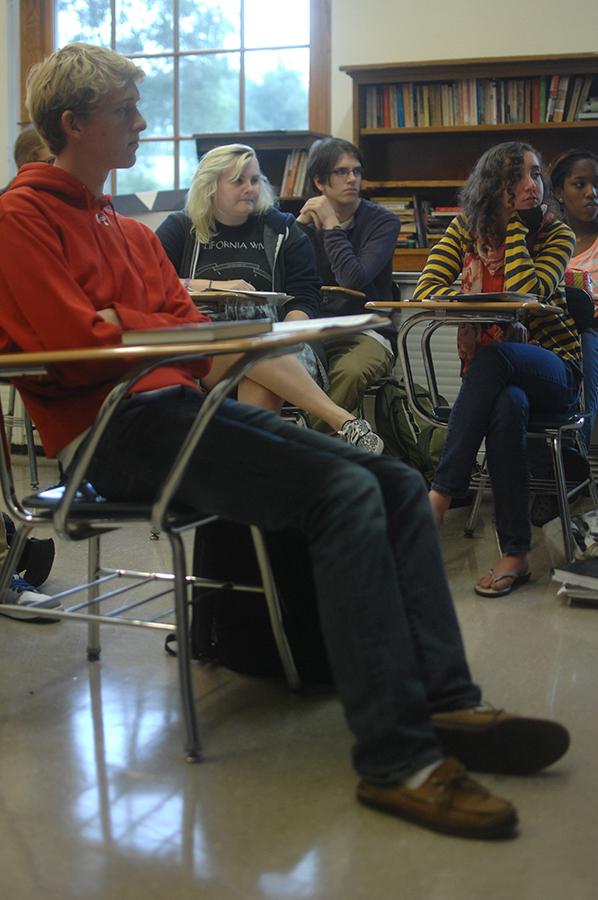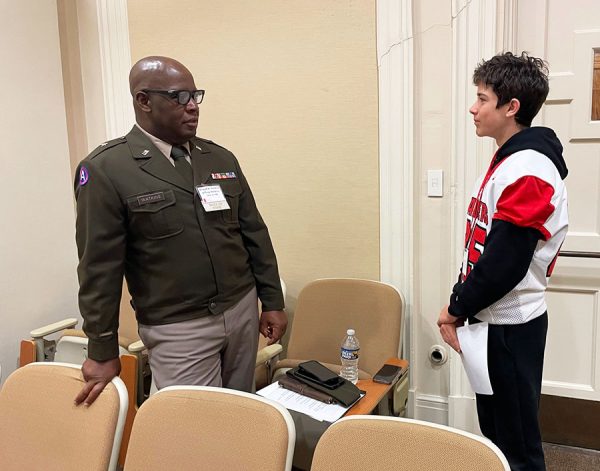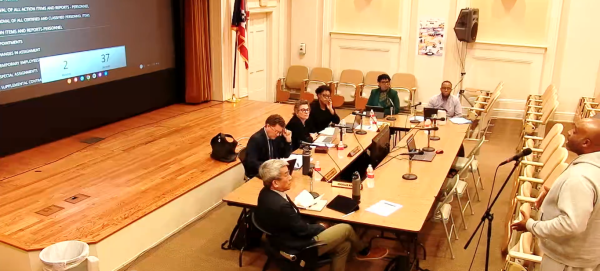Tests Raise Doubts Over AP/IB Mesh
Shaker’s lowest AP Literature scores ever have students, teachers questioning blending the 2 programs in 1 class
Christopher Cotton’s first period AP/IB Literature class includes senior McKinley Glasser, wearing stripes, who said, “It’s an engaging class with lots of opportunity for discussion.”
More than 35 percent of AP English Literature students earned a 5 on the AP exam in 2012. Last year, less than nine percent did.
“That’s really terrible,” AP/IB Literature teacher Christopher Cotton said. “I just feel so rotten for some of these kids.”
Only three students received a 5 on the exam, while 17 students earned that score in 2011, as well as in 2012. Before last year, Shaker’s lowest count of 5’s was four, in 2006 — still more than 13 percent of the students who took the test.
“This is shocking, that we only had three 5’s,” Cotton said. “You know how hard our students work at Shaker. They’re hard-working, they take the hardest courses across the curriculum, four years, and it’s not like they’re guaranteed to get a 5, but they should. A lot of them should’ve had 5’s.”
“[My score] was definitely a lot lower than I expected,” said Clara Kao (’13) one of those AP Literature students. “I thought I wrote pretty well, and I got my score back and I was pretty shocked.” She would not reveal her score.
Kao attributed the low exam scores to a particular essay question on the test. “One of the questions in part asked for us to write about a novel,” Kao said. However, her class only read two novels, George Orwell’s “1984” and Toni Morrison’s “Beloved,” both during first semester. “Myself included, I did not write about a novel, because I couldn’t remember any novels … and a lot of my other friends did that as well,” Kao said.
Calling last year’s exam “a perfect storm,” Cotton also referred to that essay question. “The AP test always has a question that asks you to write an essay based on something that you read, some book that you’ve read, and almost always they say any book, any play or novel,” he said. “But last year, they said only use a novel. And we had not read many novels.”
The class read so few novels because of International Baccalaureate Diploma Programme requirements. “The last semester of the IB two-year program in English, you have to do a focus on a single genre, and we chose drama,” Cotton said. “It’s a very elaborate balancing act, planning out the four semesters of the IB English program.” During the drama semester, students read plays by Henrik Ibsen, Tennessee Williams, Caryl Churchill and Kate Chopin, in addition to Shakespeare’s “Hamlet” during first semester.
The genre semester has always been an IB requirement. Last year, however, was the first year the AP/IB Literature class read no novels during the semester at all. “The year before [last year] . . . we maybe did one or two [novels],” Cotton said. However, “we didn’t focus on them.”
“IB wants us to do a genre semester, and that’s not a secret,” AP/IB Literature teacher and IB Extended Essay Coordinator Chuck Kelly said. “It’s not as if that’s something that’s unheard of in English to do, to send the kids out from high school really understanding a drama in-depth.
“We could always change the genre,” Kelly added. “We could make it the genre of the novel, but we feel like the students at Shaker read so many novels that this is a chance to do something new.”
In addition, changing the genre semester would involve the whole English Department. “That takes a great deal of planning, and that planning has to be done by the entire department because if you make a choice to change what you do that semester, it’s going to affect the whole Diploma Programme,” Cotton said. “If we decide, ‘OK, we’re going to do novels,’ then it may affect what the junior teachers have to do. . . . We don’t have time at this point to redo the whole Diploma Programme; it’s just not possible right now.”
Evelyn Ting (’13), an IB Literature student last year, appreciated the genre semester. “I am really glad we did those plays because I really enjoyed those plays and I don’t think I would have read them if I hadn’t been in English,” Ting said. However, she acknowledged that because “we didn’t read any novels, the AP students couldn’t answer the test questions because they didn’t know the material.
“For IB we did definitely cover the material,” Ting said. “All of the questions on the [IB] test I could answer with what we’d studied in English.”
On the IB English test last year, Shaker’s average of 5.13 points out of 7 was slightly higher than the previous year’s average, 5.00 points. Both years surpassed the worldwide averages of 4.69 and 4.77, respectively.
Nationally, scores on last year’s AP Literature test were lower than usual. According to statistics released on Twitter by Trevor Packer, the College Board’s senior vice president of AP and instruction, 7.6 percent of students nationwide earned a 5 on last year’s Literature test. The year before, 8.3 percent of students earned that score.
However, that dip in scores does not compare to Shaker’s 27-percent drop. Cotton identified the essay question on novels as the biggest reason for the lower scores, saying he “looked at the breakdown for our school, and that was the essay we did the worst on,” However, he added, “That [one essay] doesn’t explain it, because this [drop in scores] is weird.”
Kelly was relatively unsurprised by the lower AP scores. “The IB students are not taking the AP test, and [the IB Program] attracts some top students, so I’m almost — you know, I don’t mean to predict things about grades, but I would be very confident that numbers of our IB students would get 4’s and 5’s on the AP test,” he said. “So there’s just this expectation there’ll be a shift.”
To Kelly, 4’s and 5’s show similar proficiency. “We’ve always had a good percentage of 4’s and 5’s, that’s always been the case, and I thought that I still had a good percentage of 4’s and 5’s,” Kelly said. “I thought it was fewer 5’s this year than past years, but I thought I had a pretty typical percentage of 4’s and 5’s together, and in my mind, it’s hard to know why a student gets a 4 or a 5. I’ve always kind of put them together.”
In 2013, 48.6 percent of Shaker AP Literature students scored a 4 or a 5 on the exam. That percentage ties with 2007 for Shaker’s lowest amount of students earning those scores. In 2012, 62.5 percent of Shaker students earned a 4 or a 5 on the AP Literature test.
Kelly also noticed many 3’s, which he said was common. “A number of our students get 3’s, and we always get 1’s and 2’s, and there’s a reason for that. Our classes attract a wide variety of students at various levels, and that’s the way we want it,” he said. “I don’t want a class of all 4’s and 5’s if it means, if it implies, that somehow we’re not giving access to students who, you know, maybe they’re not quite as prepared for an assessment like the AP exam.
“We like the classes to be inviting to students, and if the result is some students come in from other levels and they’re, I don’t want to use the term disadvantaged, but because of that their score on an assessment isn’t as high as other students, that doesn’t — that’s not our prime goal at the end,” Kelly said. “That’s why, when I saw the scores, I said, ‘OK, we’ve got some 1’s and 2’s,’ and that’s not atypical. We’ve always had 1’s and 2’s, since I’ve been teaching AP, and I’ve always reflected on students who get those scores and concluded they get a lot from the class and contributed a lot to the class.”
Cotton was more disturbed by the 3’s he saw in his class. “I had some really good students who got 3’s, and that’s what really bothered me the most,” he said. “If you get a 3, you might not get college credit, and you might be counting on this free AP course to save you a few thousand dollars in college.”
Besides the novel-based essay question, Cotton identified another important factor in the lower scores. “We don’t do quite as much writing as we used to. And that’s not an AP/IB thing, that’s just, we have a much higher student load than we used to, so teachers don’t have time to do quite so much writing,” he said. “I just can’t assign as much writing as I used to, because it takes a lot of time to grade meaningfully.”
“The writing burden and grading it with the detail that this department has traditionally used, it’s impossible,” English Department Chairwoman Elaine Mason confirmed. “In our contract, English teachers are capped at 110 students, that’s been that way for forever and ever and ever. Yet until very recently, most English teachers had well under 110 students. Now, virtually everyone in the department who’s full time is at or very close to that cap.”
Both Kelly and Cotton agreed on one thing: neither prefers mixed AP/IB classes. However, their opinions stem from different reasons.
“Because of this preparing directly for the test, it’s much harder when the class needs such different things,” Cotton said. “The separate classes would help us to focus more on those tests, and for the AP classes, I think we would just do more novels because really, having a lot of novels under your belt is the best preparation for AP tests.”
Kelly, meanwhile, dislikes the AP-versus-IB competition in mixed classes. “I don’t like it if the students get the impression that one curriculum is unduly influencing another curriculum,” he said. “I think this will fade, but I think in the transition, students have felt that there’s this compromise going on between what they would do as AP students and what they would do as IB students because we’re doing both. And I just think that’s an unfortunate situation to put students in.”
However, due to scheduling, separating the AP and IB English classes would bring its own problems, according to Assistant Principal Ann Spurrier. Separating the classes is “not impossible,” she said. But, she added, “It is not good for kids. Right now you have five or six sections of each combined. If we separated them, you might have two sections of IB and three sections of Advanced, and that would limit the amount of sectioning available for the kids. . . . It would make it much more difficult for you guys to get what you wanted.”
When Shaker decided to adopt IB, Principal Michael Griffith said he, IB Coordinator Tim Mitchell and the high school’s department leaders met to decide “which [courses] mesh, which ones didn’t mesh. . . . It depended on the course itself, how each was being addressed or taught, the content and those kinds of things to see what worked out.”
“The development of classes for the IB program required the faculty members in 12th- grade and 11th-grade AP classes to be sent for IB training in order to learn about the program and the specifics about the courses that would be designated Higher Level or Standard Level,” Ellen Kelly, English Department chairwoman during IB’s initial implementation, wrote in an email. “Each department decided to have separate classes or to mix IB and AP classes together.”
“That [blending] was everybody’s first choice,” said Tim Mitchell, social studies teacher and IB coordinator. “That gives kids, it’s like, ‘You can try the IB,’ and if for some reason that wasn’t working for you, you don’t have to blow up a kid’s schedule. They can stay in the same course, maybe complete an AP course instead of the IB Diploma. So we were asked to see what we could do with as little disruption to what we were currently doing, and if we could find overlap, to make it so.”
Even before the workshops and meetings, “we had looked at a lot of other schools that had a blend of AP and IB or offered both programs, and so we were hopeful that we could find places to fit them together,” Mitchell said. “It’s not like we came in saying, ‘This must happen that way.’”
Blending AP and IB English classes has proven successful in other schools. At Upper Arlington High School outside of Columbus, when IB entered the district, AP scores “went up,” according to UA’s AP/IB Coordinator Cynthia Ballheim. The school separated their AP and IB Literature classes this year, but only because “we have so many electives that our students can choose from, that our IB Diploma students were never in the same class” and had “no real sense of community or continuity,” Ballheim said.
In Shaker’s case, “the IB requirements for higher-level English changed the curriculum somewhat; however, the IB trained teachers designed the new curriculum (for meeting IB guidelines) together,” Ellen Kelly wrote in her email. “There were a wide range of plays, novels, poetry and nonfiction items to select from the approved IB reading list. Some of the items selected had been taught in the past in AP classes.”
Ellen Kelly taught at Shaker for 26 years, including five years as head of the English Department, and left before IB was entirely put into place. She said, “I was in favor of mixing IB and AP classes because I thought the different requirements could be met with students in the same classes. However, I never taught a mixed IB and AP class.”
Mason said, “We have begged, begged, begged for years that these classes be separate. That, you know, they do kind of serve two different master. Could we have IB in one room and AP in a separate room? Not saying that one is better than the other; they’re just different.
“For all kinds of reasons, we were told that would be impossible in the master schedule to achieve,” Mason said. “So we’ve kind of just said, ‘OK, we have to live with that because that’s the mandate.’ ”
“I did hear some of those same concerns about the English” during the original meeting, Griffith said. “At the same time I also heard about, saw the results and watched the results all the time.”
Griffith added that “the year 35 percent of the class had 5’s also was taught meshed, so how do you explain why it worked then and didn’t work the other time? It’s not about the content, in my opinion. I don’t see how you could make a judgment that the mesh is the problem.”
Cotton, too, said AP and IB should be able to coexist in a classroom. “It’s the same skills you’re working on. The IB assessments are analyzing literature and the AP tests are all analyzing literature,” he said.
Chuck Kelly agreed. “IB did not reinvent the literary wheel,” he said. “You’re doing the same things that you would do in any strong literature class.”
“The first year it seemed to work out fine for everybody, and second year it didn’t work out as well as they’d hoped for the Literature,” Mitchell said. “But I also think that’s something it’s easy to cast stones on. ‘Well, must have been the blend.’ Then what happened the first year? I guess I don’t necessarily see that as a causal link. I mean, we have partial information. . . . Over the course of time, if we felt like those assessments were growing in different enough directions to say we need to rethink that, I’m sure we would. But that’s certainly not the case right now.”
In last year’s AP/IB Literature class, “I think that they did favor the IB curriculum,” Ting said. “I think they tried to cater to both, but the majority of what we read were plays. [. . .] Although it might’ve had some overlap with AP, those were the works that were all in IB curriculum.”
Ting also pointed out that teachers are dividing their teaching efforts equally between IB and AP, although most students in a given class are not IB students. “So I think maybe it’s just a matter of it not representing the majority in the class,” she said. “The majority talks louder than the minority.”
“I think the [mixed AP/IB] junior year is very similar to what existed before. The senior year is a different story,” Mason said. “I don’t feel we have the same pressure in the junior year. . . . It’s not like we have to do this, this and this. They give you lists of literally hundreds of books that you get to choose from [for junior year], so I still feel like the choices were very much our own.”
The senior English teachers had to make more changes. In addition to the genre semester, teachers must facilitate IB students’ Individual Oral Commentaries. IOC’s are IB oral assessments, in which students receive a passage of literature, analyze it and speak about their analysis for 10-15 minutes. The commentary, which is recorded, is then sent to the IB Programme’s main office for formal evaluation.
“The Individual Oral Commentaries take an enormous amount of a teacher’s time, and I think that’s time that’s taken away from their preparation and grading for the class as a whole, and it’s only devoted to IB students,” Mason said. “I think that time crunch really hurts.”
Kao said, “All around, I’ve had issues with the mixed classes, not just in English.” Specifically, she mentioned a Latin class with Honors, AP, IB Standard Level and IB Higher Level students. “Each one had a different curriculum, basically,” she said. “We didn’t really get anything done . . . and you could see it in our test scores.”
“That’s a very spot-on assessment,” Latin teacher Robert White said. “I don’t think, in all the years I’ve done this, I’ve ever had students who did not-as-expected on the exam. Had we not had them [AP and IB] together, they would’ve done better. I think the IB students did OK, but the AP students were not happy with their grades.”
AP and IB Latin were mixed for two years, but “the aims and goals and the styles [of the programs] are totally different,” White said. “Both programs are really good, they just have different goals in their assessment of students.”
Now that the classes are separate, “I feel more confident for the students taking those exams,” White said. “We haven’t seen anything yet to make us regret that decision to split them up.”
“It’s hard — mixed curriculums,” Kao said. “They’re really just teaching two classes in one, and that’s really not fair to us or to the teacher.”
Cotton did not feel one curriculum had been favored over another in his class. However, “The district has just been focusing so much on IB,” he said. “I don’t think that the AP parents are complaining, but that’s what it’ll take to make a change.”
In the meantime, this year’s curriculum will change. “We’re doing more writing. And more direct practice of the AP test, like giving people stuff directly off the AP test,” Cotton said. “We’re going to spend more time practicing the multiple choice questions, and we’re going to do more AP essays during the course of the year.”
The class will read more novels, too. “We were thinking of doing two novels during that [genre] semester,” Kelly said. “We’re not relegated only to the genre of drama because IB says so. We have flexibility and we’re taking advantage of that.” But, he said, “We did not make that decision based on any assessment. We made that to enhance [the unit].”
“In previous years we’ve tried to do two plays by every author,” Cotton said. However, to fit in more novels this year, “some of those writers, we’re just going to do one play by them and we’re going to substitute a novel to sort of go with the play we’re reading. So the novel will complement the play.”
With the curriculum changes, Cotton hopes this year’s scores will see significant improvement. “I can’t find any reason to justify these kinds of scores,” Cotton said. “I hope it’s a fluke and I want to make it a fluke, you know, by having much better scores this coming year.”
If the scores stay low, however, change is possible. “We’re going to be, I think, a year out from a five-year review of IB,” Griffith said. “That means we have to look at all of our structure and all of our classes and how is it working, how do we think it’s worked, is there room for tweaking, what’s next, you know? So there will be — as is appropriate, the whole IB process is a time for reflection — and therefore time for maybe, if necessary, for change.”
“We’ll definitely bring up the issue,” Cotton said. “We would like to separate them [the classes], but it just seems like it hasn’t been possible because of the scheduling.” However, he said, “Especially as IB grows in the district . . . I think it would be a good idea to separate them if we could in the future. We’ll definitely talk about that and we’ll suggest that.”
“If it turns out that there’s decisions about some classes to make change because we think it’s going to make things better, so be it,” Griffith said. “We shouldn’t shy away from that.”





